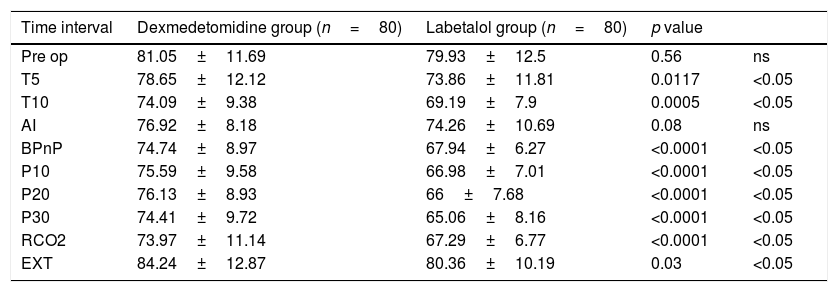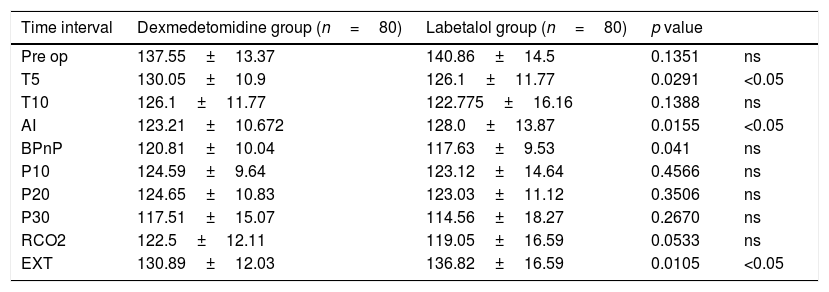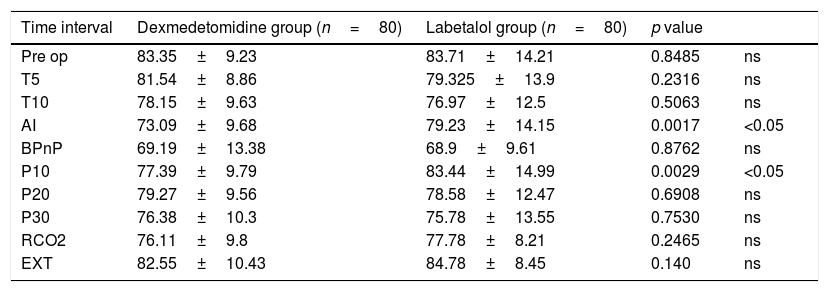Various pharmacological agents have been tried to attenuate the pressor response in laparoscopic cholecystectomy patients. We have compared single pre-induction intravenous injection of dexmedetomidine with labetalol for attenuation of hemodynamic stress response.
MethodsA total of 160 patients were considered for this prospective, randomised, double blind clinical study done in a single tertiary care institution. Patients were either included in group D, to receive 1.0μgkg−1 i.v. dexmedetomidine or group L, to receive 0.3mgkg−1 i.v. labetalol in 100ml of normal saline before induction of anaesthesia. Patient's hemodynamic parameters were noted pre-operatively before starting infusion and at fixed intervals afterwards till extrubation.
ResultsAfter intubation, mean systolic blood pressure (SBP) was higher in patients of group L (128.0±13.866) as compared to group D (123.2±10.672). Afterwards the SBP was comparable until extrubation. Similarly, after intubation patients in group D tended to have lower diastolic pressure (73.1±9.683 vs. 79.2±14.153, p value 0.0017) compared to patients in group L. Also, the relative incidence of bradycardia and hypotension was higher in patients who had received inj. labetalol.
ConclusionIn patients predisposed to significant fluctuations in blood pressure or heart rate dexmedetomidine may be more suitable than labetalol due to better preservation of normal hemodynamics especially during periods of stress showing a relatively lower incidence of side effects.
Diversos fármacos han tratado de atenuar la respuesta vasopresora en los pacientes de colecistectomía laparoscópica. Comparamos la inyección intravenosa preinducción única de dexmedetomidina y de labetalol para atenuar la respuesta de estrés hemodinámico.
MétodosConsideramos a un total de 160 pacientes para este estudio prospectivo, aleatorizado y doble ciego, realizado en un único centro de atención terciaria. Incluimos a los pacientes en el grupo D, quienes recibieron 1μg/kgP iv de dexmedetomidina, o el grupo L, quienes recibieron 0,3 mg/kg-1 iv de labetalol en 100ml de suero salino normal antes de la inducción de anestesia. Se anotaron preoperatoriamente los parámetros hemodinámicos de los pacientes, antes de iniciar la infusión, y a intervalos fijos, hasta la extubación.
ResultadosTras la intubación, la presión arterial sistólica (PAS) fue más alta en los pacientes del grupo L (128 ± 13,866) en comparación con el grupo D (123,2 ± 10,672). Posteriormente, la PAS fue comparable hasta la extubación. De igual modo, tras la intubación los pacientes del grupo D tendieron a tener una presión arterial diastólica más baja (73,1 ± 9,683 vs. 79,2 ± 14,153, valourp de 0,0017) en comparación con los pacientes del grupo L. También la incidencia relativa de bradicardia e hipotensión fue mayor en los pacientes que habían recibido labetalol.
ConclusiónEn los pacientes con predisposición a fluctuaciones significativas de la presión arterial, o de la frecuencia cardiaca, la administración de dexmedetomidina puede resultar más adecuada que labetalol, debido a una mejor conservación de la hemodinámica normal, especialmente durante el periodo de estrés, habiendo reflejado una menor incidencia relativa de efectos colaterales.
Artículo
Comprando el artículo el PDF del mismo podrá ser descargado
Precio 19,34 €
Comprar ahora












